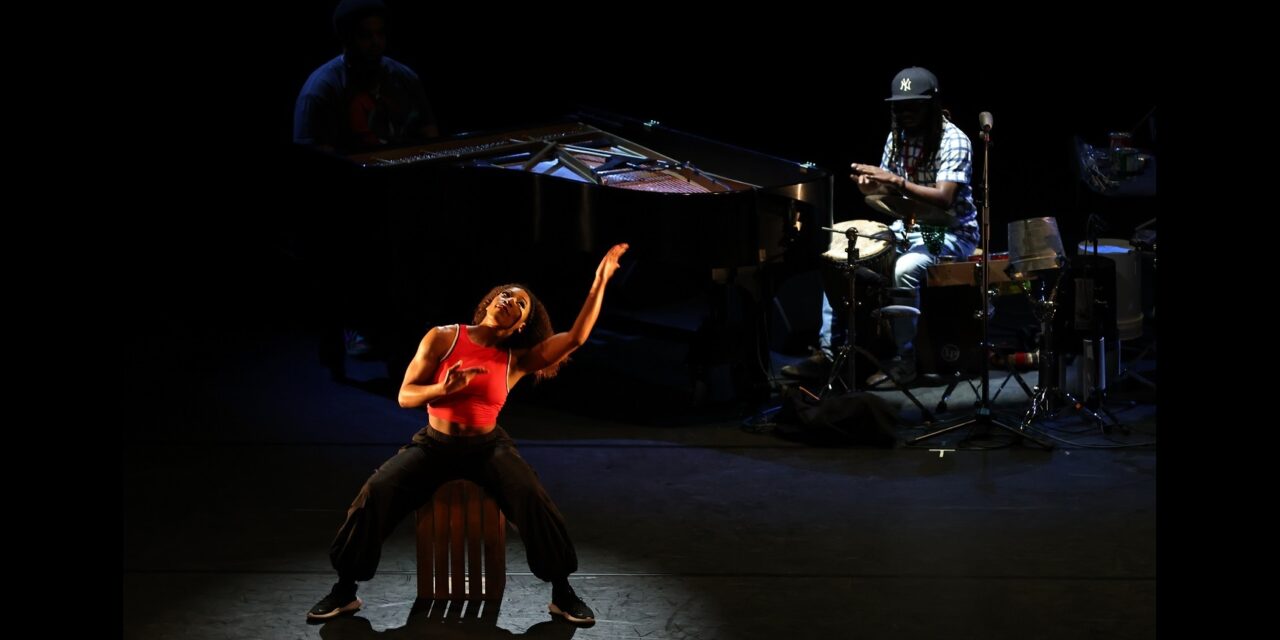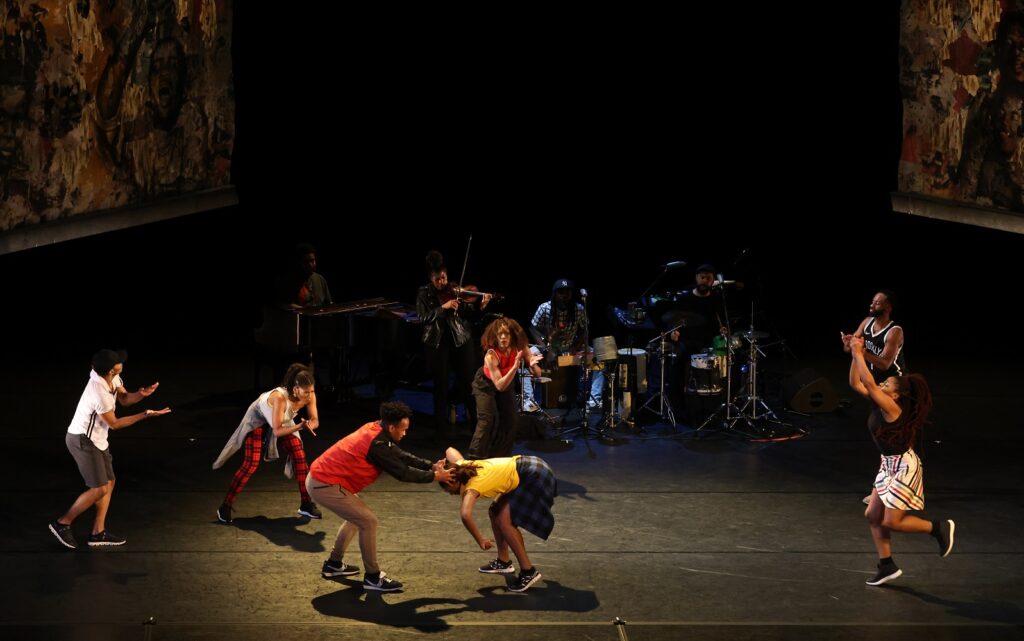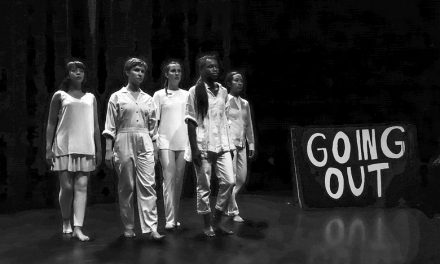Chapman University’s Musco Center for the Arts presented Camille A. Brown & Dancers 2017 work, “ink,” featuring dancers Quilan Arnold, Dorse Brown, Starla Edwards, Onyxx Noel, William Roberson, Courtney Ross, and Asya Shaw. “In collaboration with Music Director Allison Miller, percussionist Wilson Torres, violinist Juliette Jones, and composer/pianist Scott Patterson,” “ink” was created as the “final installation of [Brown’s] dance theatre trilogy about identity” in the black experience. Through her distinctive fusion of African American social dance, African, Tap, Jazz, Modern, and Hip-Hop, “ink” explores the superhero-ness and manifold manifestations of Black joy in “love, brotherhood, exhaustion and resilience, community and fellowship.”
Culture Codes opens with the lights coming up on soloist Asya Shaw who is sitting downstage center on a wooden stump. In silence, her arms begin to speak—summoning, stirring, consoling, declaring, and asserting. A live band sits quietly behind her—Kwinton Gray (piano), Nyemba Seales (percussion), Dillon Vado (percussion). She is framed by two large portraits hanging on either side by Lighting and Scenic Designer David L. Arsenault. As Shaw’s soliloquy continues, drummer Dillon Vado joins in, his role seamlessly transitioning between conversation partner and amen corner. The rhythmic interplay between Vado’s drumming and Shaw’s movement display a rousing exchange. The audience is especially delighted by the moments of random synchrony where a singular drum beat amplifies and punctuates one of Shaw’s gestures.
Balance features a teasingly tender duet danced by Courtney Ross and Dorse Brown. Behind them, the band plays a beautiful jazzy number in 7, providing a wonderful sonic backdrop for Ross and Brown to showcase the characteristic playfulness and silly ways flirtation, admiration, and affection are exchanged in black romance.
Milkshake features a sassy duet including Courtney Ross and introducing Onyxx Noel. Set against a funky drum score accented by the dancers’ hand clapping, this showed the solidarity between sisters who were forces in their own right, and so much more together. Noel was electric, filling the stage with an incredible energy as her body moved easily between percussive and serpentine movements. It was hard to sit still and be quiet as you watched her. Some failed altogether yelling out “Dance sis!”
In TURF, duo Dorse Brown and William Roberson show the journey from innocence to guardedness that too many young Black men are forced to take. I absolutely love the dynamic between Brown and Roberson, who gain our affection through their physical storytelling. Both are admiringly committed to take us along the ride through every vividly portrayed emotion and significant moment. As a teacher and sister to a younger brother, I was deeply impacted by seeing Black men get to experience wonder and innocence and silliness and joy. I was tickled by the inclusion of characters and interactions that seem to be found in any relationship between Black boys and men, like the playful antagonism and the over-exaggerator that no one takes seriously, but never excludes. Brown and Roberson’s brilliant physicality shows us the heartbreaking transition they are forced to navigate—from the silly, innocent, and beautiful Black boys who are allowed to dream and wonder to the necessary hardening they must embody to survive.
Migration begins with Starla Edwards and Quilan Arnold whose poignant depiction of caring for one another still replays in my mind. This theme of care is amplified throughout the duet by violinist Juliette Jones, who traces a repetitive circular perimeter around the pair as she plays. In this duet, we first see the two engaging in normal couple interactions. Then something shifts and Arnold is struggling. Edwards answers the call, tenderly standing behind Arnold. She gives him space but her arms are stretched out wide to create safety as he spirals. Periodically, she assures him with an embrace. We witness this go on for some time and it is heartening to see love provided through physical and temporal space.
When the roles switch, I can hardly contain myself. My chest tightens with emotion as Arnold provides space and safety for Edwards to let go and spiral. At one moment, I almost completely lose it—Arnold takes hold of Edward’s head as she crouches over. Tears fill my eyes as I fixate on his hands unflinchingly embracing her as she exposes her vulnerability. Then in a rapturous moment, the cast fills the stage surrounding the couple to love on them as they love on one another. It is overwhelming in the most powerful of ways. The group claps with fervent intention as they fix their gaze on the couple as if they were transmitting healing through their presence, focus, and the air wielded between their claps.
Camille A. Brown and her incredible cast have forged a style that resonates very deeply. I chuckled inside as I watched them on stage because I understood their conversation. I’ve had those conversations with friends and family using that movement. It was fascinating to realize that Black people have a physical vernacular. We are not a monolith so it is not an exact science but there is enough of a foundation there that we can weather dialectical differences. “ink” beautifully did what it set out to do—to show Black people in joy enjoying one another, come what may.
Sound Design: Justin Ellington; Costume Supervisor: Amy Page; Costume Designer/Stylist: Mayte Natalio; Dramaturgs: Daniel Banks, Kamilah Forbes, Talvin Wilks; Lighting Supervisor: Jane Chan; Rehearsal Director: Mora Amina Parker.
To learn more about Camille A. Brown & Dancers, please visit their website.
To learn more about the Musco Center for the Arts, please visit their website.
Written by Marlita Hill for LA Dance Chronicle.
Featured image: Camille A. Brown & Dancers in ink – Musco Center Photo by Karen Tapia












